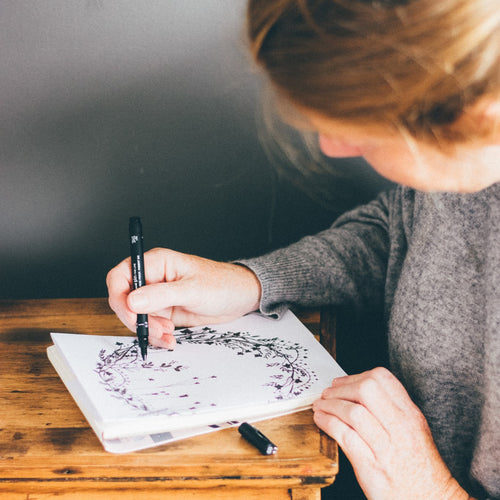Here in South East Cornwall we are approaching Bluebell time of year!
I was looking back over some of my entries in this journal and was drawn to last year’s Bluebell blog, “British Bluebells” which provides the background to my inspiration for our beautiful Bluebell Collection and gives some ideas of where to find them both in this part of Cornwall and around the country.
The bluebell has many names: English bluebell, wild hyacinth, wood bell, bell bottle, Cuckoo’s Boots, Wood Hyacinth, Lady’s Nightcap and Witches’ Thimbles – its Latin name is Hyacinthoides non-scripta.

Ideal Conditions for Bluebells
Bluebells thrive in partial shade under deciduous trees or shrubs and need moist but well drained soil, so when you are thinking of hunting out likely places for Bluebells, look for old or ancient woodland.
Native bluebells are fragile plants, they don’t like change or disturbance and prefer ancient woods where the ground has lain undisturbed for years. It’s no surprise then that almost half of the world’s bluebells are found in the UK, they’re relatively rare in the rest of the world.
The introduction of the more robust Spanish Bluebell, about 300 years ago, into British gardens has led to them to form hybrids with native flowers, producing wider leaved, scent free plants in some places.
Our native blue bells are slightly smaller, have narrow leaves, drooping heads, a violet bell-shaped flower and a delicate, distinctive fragrance.
If you are unable to get out this year, the National Trust has an amazing tour of a Bluebell wood which will transport you directly into the woods with beautiful bird song and wonderful carpets of bluebells.

Bluebells are Delicate
Bluebell colonies can take time to establish, around 5-7 years from seed to flower and can take years to recover after footfall damage, since if a bluebell’s leaves are crushed, they die back from lack of food as the leaves cannot photosynthesise.
So, tempting though it is to have a photo taken amongst the bluebells, remember to stay on the paths to preserve these ancient flower beds.
For me, the sweet smell of Bluebells is intoxicating and the shimmering carpet of blue that we see each year under the trees brings a simple joy and satisfaction that summer is on its way.
The same carpet of blue flowers had captivated poets and artists over the centuries from Oscar Wilde, Emily and Anne Bronte, Gerard Manley Hopkins and Percy Bysshe Shelley.
As one of Britain’s best loved flowers, they also play a really important role in keeping woodland eco systems going.
Bees, butterflies and hoverflies are all attracted to them and they provide essential nectar during the early spring.
For that reason, they are also great plants for your garden. Be sure to follow advice about getting the right British Bluebell bulbs to help sustain the population.

Bluebells in Myths and Folklore
In folklore, bluebells were said to form a ring when fairies were summoning their kin to a gathering; but if a human heard their sound, it would be their death knell.
Not surprisingly it was considered unlucky to trample on a bed of bluebells because you would anger the fairies resting there.
There is also an interesting belief that wearing a garland of bluebells will induce you to speak only the truth!

Other Facts
The bluebell is the flower of St George, since it often starts to bloom around St George’s Day on 23rd April, although here in Cornwall, it’s a little earlier. It’s sap was once used in bookbinding because it would repel attacks by insects and in early times it was also used to make a glue to stick feathers onto the shaft of an arrow.
All parts of the bluebell plant contain toxins and the leaves have been known to cause digestive problems in cattle and horses. Touching its sap may cause dermatitis too, so definitely observe, but don’t touch!

We are looking forward to seeing lots of visitors in our shop from 12th April onwards to marvel at the wonderful Bluebells that you can find around the coast here. If you are in the area, don’t hesitate to pop in to say hello! You may be inspired to pick up a celebratory Bluebell mug, greetings card, tea towel, bread bag or other Bluebell memento of your time in Mount Edgcumbe Country Park!

If you are out and about, please do share your images of bluebells with us, they are one of the special flowers of spring and very dear to me. Share on Facebook or Instagram.
For priority access to our sales, new products, gift ideas and events sign up to our newsletter here.




Leave a comment